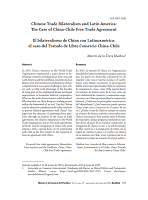Chinese Trade Bilateralism and Latin America: The Case of China-Chile Free Trade Agreement
DOI:
https://doi.org/10.32870/mycp.v9i27.687Palabras clave:
free trade agreements, bilateralism, Latin America and the Caribbean, China, China-Chile Free Trade AgreemenResumen
In 2001 China’s entrance to the World Trade Organization represented a major threat to developing countries including those from Asia and Latin America and the Caribbean. Countries such as Mexico were worried about its inclusion for China’s competitiveness was a great challenge to face; others such as Chile took advantage of the benefits of being part of the multilateral forum and began negotiations to formalize bilateral cooperation. What are the main characteristics of bilateralism? What benefits can China bring as a trading partner within the framework of an FTA? Can the Chilean case be taken into consideration for other countries to pursue bilateral agreements with China? This paper has the objective of answering those questions through an analysis of the scope of trade agreements, the Chinese integration to the World Trade Organization and its free trade agreements network, and the integration of China with Latin America, with a special focus on its relationship with Chile as the first country in the continent to have an agreement with China.Descargas

Descargas
Publicado
Cómo citar
Número
Sección
Licencia
Política de acceso abierto
Esta revista proporciona un acceso abierto a su contenido, fiel al principio de que ofrecer al público un acceso libre a las investigaciones ayuda a un mayor intercambio global del conocimiento.
MyCP se publica bajo la licencia de Creative Commons Reconocimiento-No Comercial CC BY-NC
Los contenidos serán publicados en versión PDF y XML.
Los autores(as) que publiquen en México y la Cuenca del Pacífico aceptan las siguientes condiciones:
De acuerdo con la legislación de derechos de autor, México y la Cuenca del Pacífico reconoce y respeta el derecho moral de los autores(as), así como la titularidad del derecho patrimonial, mismo que será cedido a la Universidad de Guadalajara para su difusión en acceso abierto.
México y la Cuenca del Pacífico no realiza cargos a los autores(as) por enviar y procesar artículos para su publicación.
Los autores(as) pueden realizar otros acuerdos contractuales independientes y adicionales para la distribución no exclusiva de la versión del artículo publicado en México y la Cuenca del Pacífico (por ejemplo, incluirlo en un repositorio institucional o darlo a conocer en otros medios en papel o electrónicos) siempre que indique clara y explícitamente que el trabajo se publicó por primera vez en México y la Cuenca del Pacífico.
Una vez que se acepte el artículo para su publicación los autores(as) deben remitir el formato de carta-cesión de derechos de la publicación debidamente requisitado y firmado por los autores(as). Este formato debe ser remitido en archivo PDF paralelamente con la versión final del artículo al correo: mexicoylacuenca@gmail.com.
Los lectores/usuarios de México y la Cuenca del Pacífico pueden acceder directamente al contenido de manera libre y gratuita en todo momento, incluyendo cuando un nuevo número es colocado en la plataforma. Se permite al lector/usuario citar, compartir (electrónicamente y de manera física), imprimir y distribuir el material siempre que se indique de manera clara y explícitamente que el trabajo se publicó por primera vez en México y la Cuenca del Pacífico. Es necesario citar de manera correcta el trabajo y no debe de ser utilizado con fines comerciales.




